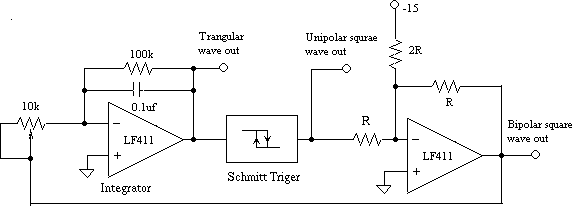
- #BIPOLAR SQUARE WAVE VS UNIPOLAR SQUARE WAVE MOD#
- #BIPOLAR SQUARE WAVE VS UNIPOLAR SQUARE WAVE FULL#
But the main goal isn't perfect shapes, it's imitating FM, and it does that very well. There's a trimmer control to adjust it but the little spike is probably never going to disappear. No analog waveshaper is perfect - if you look at the triangle output of most saw core analog oscillators, you'll see a similar "glitch."įM Aid in particular isn't calibrated for a specific VCO input. The square wave in particular doesn't even look like a square wave.
#BIPOLAR SQUARE WAVE VS UNIPOLAR SQUARE WAVE MOD#
So you could, for example, put a half wave rectifier in front of its mod input to get AM sounds from a couple VCO's, rather than ring mod sounds.įM Aid's all waveforms looks glitchy in video demo. You can perform unipolar AM with a ring modulator if you just make sure your modulator is only sending positive voltages, like you mention in your comment. A ring modulator (also sometimes called a 4 quadrant multiplier) will pass the inverse of your carrier signal when the modulator goes into negative voltages. The VCA will ignore negative voltages on the modulation input, so you only hear the carrier signal during the positive portion of your modulation signal. Unipolar AM is what you will get from a typical VCA, and bipolar AM is what you (can) get from a ring modulator. Not a silly question at all! That is essentially the idea, but the type of module you use plays into it. 20 cycles in 1/10th sec = 200 cycles per second.- unipolar vs bipolar AM - I know this is probably a silly question but is this just about what you use for a modulating signal? (Bipolar or unipolar source) or does this require 2 different types of modules to make this happen? 5 cycles in 1/10th sec = 50 cycles per second.īottom: a sinusoidal 200 Hz wave.
#BIPOLAR SQUARE WAVE VS UNIPOLAR SQUARE WAVE FULL#
Waveforms that repeat one full cycle a greater number of times per second will have a higher frequency, eg the current in Figure 8b has a frequency four times greater than the current in Figure 8a.įigure 8. If there are 50 cycles every second, that means one full cycle is completed in 20 milliseconds this duration is known as the period of the current. For example, ‘standard’ mains electricity in Europe is characterised by a sinusoidal waveform with a frequency of 50 Hz, ie it repeats 50 times per second (Figure 8a). The frequency of a current is the number of repetitions of one complete cycle of the waveform per second and it is measured in hertz (Hz). (Note: this figure is for descriptive purposes only, to enable understanding of electrical terminology the waveforms shown are not necessarily appropriate for humane electrical stunning of animals.)

Time is typically described in milliseconds (ms). However, so far, scientific research indicates that carcass quality is not necessarily improved when waveforms are altered and a sine AC appears to produce the most effective stuns for animal welfare.įigure 7. A variety of waveforms (including some of those shown in Figure 7) have been used in electrical waterbath stunners, mainly to attempt to reduce carcass damage or to improve the efficacy of the electrical pulse. Or a wave can be clipped to produce various different shapes. For example, AC waves can be rectified to different degrees (eg half or fully) to produce DC waves (eg pulsed or constant, respectively). Current can also be modified to produce different waveforms. For example, waves can be smooth undulating curves (sinusoidal or sine), square or rectangular, sawtooth or triangular. The way an AC or DC current flows can be examined over time to reveal the shape/form of the wave. An alternative description of this is the duty cycle, where the duration of the mark is expressed as a percentage of the duration of the cycle time. The resulting waveform can be expressed by the mark:space ratio (where the mark is the time the current is ‘on’ and the space is the time the current is ‘off’, ie at zero).

DC currents are typically pulsed (pDC), meaning the current is turned off (zero amplitude) for a proportion of the cycle time.

Alternatively, a direct current (DC) flows in only one direction (unipolar), either the positive or the negative (Figure 7b,d). Current can be generated as an alternating current (AC), where the direction of the current flow alternates around zero with positive and negative direction (bipolar Figure 7a,c,e,f). The waveform describes the shape of one cycle of the voltage or current.


 0 kommentar(er)
0 kommentar(er)
